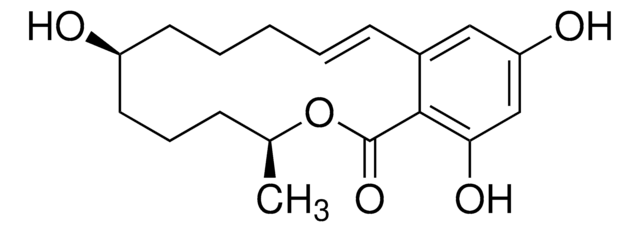CRM16869
Diquat metabolite Monopyridone
certified reference material, TraceCERT®, Manufactured by: Sigma-Aldrich Production GmbH, Switzerland
Synonym(s):
1-Oxo-9,10-dihydro-1H-10a-aza-8a-azoniaphenanthrene chloride, 6,7-Dihydro-9-oxo-9H-dipyrido[1,2-a:2′,1′-c]pyrazin-5-ium chloride
About This Item
Recommended Products
grade
certified reference material
TraceCERT®
Quality Level
product line
TraceCERT®
shelf life
limited shelf life, expiry date on the label
manufacturer/tradename
Manufactured by: Sigma-Aldrich Production GmbH, Switzerland
format
neat
storage temp.
2-8°C
SMILES string
O=C1N2CC[N+]3=CC=CC=C3C2=CC=C1.[Cl-]
InChI
1S/C12H11N2O.ClH/c15-12-6-3-5-11-10-4-1-2-7-13(10)8-9-14(11)12;/h1-7H,8-9H2;1H/q+1;/p-1
Looking for similar products? Visit Product Comparison Guide
Related Categories
General description
Certified content by quantitative NMR incl. uncertainty and expiry date are given on the certificate.
Download your certificate at: http://www.sigma-aldrich.com
Diquat monopyridone is a common degradation product of Diquat. Diquat is a nonselective, defoliant, preharvest, and desiccant herbicide that belongs to the bipyridinium class. Diquat can rapidly penetrate through the leaf surface but is not taken up by the roots, due to its strong adsorption onto the soil particles. Its activity is based on the liberation of the superoxide anion radical, followed by hydrogen peroxide, causing tissue destruction by oxidative stress. The herbicidal activity of diquat is more pronounced in daylight, aerobic conditions, high humidity, and temperature.
Diquat is not approved for its use in the European Union. The maximum residue limit (MRL) for diquat presence in the crops varies between 0.05 mg/kg in most of the commodities to 10 mg/kg for linseed and barley.
The EU residue definitions are broader, however, the toxicological data is still missing for the diquat metabolites, monopyridone and dipyridone, to compare their toxicity with the parent compound.
Application
- Detection of two diquat metabolites in urine and serum of poisoned patients after ingestion of combined herbicides, paraquat and diquat
- Analysis of paraquat, diquat, and two diquat metabolites in biological materials by high-performance liquid chromatography coupled with UV and fluorescence detectors
Legal Information
Not finding the right product?
Try our Product Selector Tool.
Signal Word
Danger
Hazard Statements
Precautionary Statements
Hazard Classifications
Acute Tox. 2 Inhalation - Acute Tox. 3 Dermal - Acute Tox. 3 Oral - Aquatic Acute 1 - Aquatic Chronic 1 - Eye Irrit. 2 - Skin Irrit. 2 - Skin Sens. 1 - STOT RE 1 Oral - STOT SE 3
Target Organs
Respiratory system
Storage Class Code
6.1A - Combustible acute toxic Cat. 1 and 2 / very toxic hazardous materials
WGK
WGK 2
Flash Point(F)
Not applicable
Flash Point(C)
Not applicable
Certificates of Analysis (COA)
Search for Certificates of Analysis (COA) by entering the products Lot/Batch Number. Lot and Batch Numbers can be found on a product’s label following the words ‘Lot’ or ‘Batch’.
Already Own This Product?
Find documentation for the products that you have recently purchased in the Document Library.
Our team of scientists has experience in all areas of research including Life Science, Material Science, Chemical Synthesis, Chromatography, Analytical and many others.
Contact Technical Service
![[Des-Tyr22]-Calcitonin salmon](/deepweb/assets/sigmaaldrich/product/images/282/634/15345f68-95be-4b5f-abc2-cb170099f26f/640/15345f68-95be-4b5f-abc2-cb170099f26f.jpg)





